Employee feedback loop: The secret sauce for employee retention

Think of a sports team during a high-stakes game. The coach might call the plays, but it’s the players on the field who see the gaps, spot the opponent’s weaknesses, and adjust in real-time.
Without constant communication between the players and the coach—feedback moving both ways—the team would crumble under pressure. Instead, it’s this back-and-forth that turns a good team into a championship-winning one. This is exactly how an employee feedback loop works in the workplace.
It ensures everyone’s insight contributes to the bigger strategy, keeping the organization flexible and effective. In this blog, we’ll dive into how you can create a winning feedback loop that drives collaboration, innovation, and success. Ready to level up your team’s game? Let’s go!
Blog Highlights


What is an employee feedback loop?

An employee feedback loop is a continuous process of gathering, analyzing, and acting on employee feedback to improve workplace practices and engagement. It involves four key stages: collecting feedback, analyzing data, communicating findings, and taking action. Closing the loop is crucial—employees must be informed about how their input has led to changes.
This system goes beyond annual reviews, relying on real-time input to enhance team dynamics, uncover issues, and boost innovation. By fostering open communication, organizations empower employees to contribute actively to their growth and the company’s success, improving morale, productivity, and collaboration.



Feedback is the breakfast of champions.
Co-Founder
Blanchard
What are the three types of feedback loops?

The three types of feedback loops—positive, negative, and balancing. Understanding these loops helps us comprehend how systems evolve and adapt, for better or worse.
1. Positive feedback loop
Positive feedback loops amplify changes, driving exponential growth or decline. In organizations, they can reinforce success or challenges rapidly. For example, a successful product launch can increase demand, leading to more investment and further growth.
While beneficial for momentum, unchecked positive feedback loops may lead to overextension or instability. Organizations must manage them carefully to sustain growth without risking imbalance or inefficiencies.
2. Negative feedback loop
Negative feedback loops counter deviations, promoting balance and stability. They act as corrective mechanisms to align actions with goals. Performance reviews exemplify this by identifying skill gaps and implementing training to address them.
These loops ensure consistency and enable swift responses to challenges, fostering operational efficiency. By focusing on continuous improvement, negative feedback loops help organizations sustain success and adapt effectively to evolving circumstances.
3. Balancing feedback loop
Balancing feedback loops stabilize systems by managing opposing forces to maintain equilibrium. For instance, work-life balance initiatives ensure productivity doesn’t lead to employee burnout.
These loops prevent overemphasis on one aspect at the expense of another, promoting long-term sustainability. By harmonizing different priorities, balancing loops contribute to a healthier workplace and ensure growth and well-being coexist, driving enduring organizational success.
Input vs feedback in the workplace
| Aspect | Input | Feedback |
|---|---|---|
| Definition and purpose | Information, ideas, or data provided to influence future decisions or actions. | Evaluations or responses assessing past actions or outcomes. |
| Timing | Occurs before tasks or decisions are executed. | Occurs after tasks or decisions are completed. |
| Nature of information | Speculative or advisory, focusing on recommendations and possibilities. | Based on concrete experiences and outcomes. |
| Impact on processes | Shapes the approach to upcoming projects, preventing potential issues. | Identifies strengths and weaknesses to improve future performance. |
| Examples in the workplace | Employees suggesting new strategies during planning meetings. | Managers providing performance reviews after project completion. |
Why is the feedback loop important?

A feedback loop is the process of gathering input, analyzing it, and using insights to drive continuous improvement. It helps refine products, boost user satisfaction, and stay competitive. Here's how it works:
- Continuous improvement: Employee feedback helps refine practices, ensuring to create a workplace that adapts and evolves to meet their needs effectively.
- Identify challenges: It allows us to uncover hidden pain points, inefficiencies, or obstacles, enabling us to take targeted actions to improve experience.
- Drive innovation: Their insights spark new ideas and solutions, helping them stay innovative and aligned with what matters most.
- Foster engagement: When companies act on employee feedback, it builds trust and fosters a sense of ownership, leading to greater engagement and satisfaction.
- Enhance retention: Listening to employee feedback helps create a supportive environment, boosting loyalty and reducing turnover.
- Shape organizational culture: Employee voice plays a key role in building a positive and inclusive culture where everyone feels valued and motivated to contribute.
Components of a feedback loop
Let's break down the components of a feedback loop and see how they come together to create a powerful mechanism for improvement.
- Input: This is the starting point of any feedback loop. It's where you gather information or data about a particular process, product, or situation. Input can come from various sources like customer surveys, employee performance evaluations, or data analytics. Think of it as the raw material you need to work with.
- Processing: Once you have your input, it's time to process it. This involves analyzing the data to identify patterns, trends, and areas that need attention. It's like sifting through a pile of puzzle pieces to find the ones that fit together.
- Comparison: After processing the data, you compare it against your goals, benchmarks, or key performance indicators (KPIs). This step helps you understand whether you're on track, falling short, or exceeding expectations. It's like checking your progress on a road trip by comparing your current location to the map.
- Feedback: Now comes the critical part – giving feedback. This can be in the form of performance reviews, product improvement suggestions, or even acknowledging a job well done. The feedback should be specific, actionable, and relevant to the situation. It's like providing directions to a traveler to help them navigate the road.
- Action: Feedback alone won't make the loop complete. Action is where you make changes, adjustments, or improvements based on the feedback received. It's the "doing" part of the loop, where you take steps to address the identified issues or capitalize on opportunities.
- Evaluation: After taking action, it's time to evaluate the impact. Did the changes you made lead to the desired outcomes? This step helps you measure the team effectiveness for your actions and whether they brought you closer to your goals.
- Adjustment: Depending on the evaluation results, you may need to make further adjustments. If the changes didn't produce the desired results, you might need to try a different approach. This step keeps the loop dynamic and adaptive.
- Iteration: A feedback loop isn't a one-time event; it's a continuous cycle. After completing one loop, you start the process again with new input. This iterative approach ensures that you're constantly learning, adapting, and improving.
- Feedback culture: Lastly, fostering a feedback culture within your organization or team is essential. Encourage open internal communication, where feedback is welcomed, and team members feel comfortable sharing their thoughts and ideas. A strong team culture keeps the loop in motion.



Make feedback normal. Not a performance review.
Executive Coach
10 Advantages of a positive feedback loop

A positive feedback loop offers several advantages in various contexts. Here are ten key advantages:
- Amplification of desired outcomes: Positive feedback loops can amplify and accelerate the achievement of desired outcomes. As the loop reinforces the initial change or stimulus, it leads to exponential growth or progress toward the intended goal.
- Rapid innovation and progress: Positive feedback loops can drive rapid innovation and progress. They facilitate the generation and dissemination of new ideas, leading to the adoption and improvement of innovative practices or technologies.
- Increased motivation and engagement: Positive feedback loops boost motivation and engagement. When individuals receive recognition or positive reinforcement for their efforts or achievements, it enhances their sense of accomplishment and encourages them to continue their endeavors.
- Reinforcement of positive behavior: Positive feedback systems and loops reinforce positive behavior by rewarding and acknowledging desired actions or results. This helps establish a culture that promotes excellence and encourages individuals to repeat and build upon successful behaviors.
- Enhanced learning and skill development: Positive feedback loops facilitate learning and skill development. When individuals receive feedback that highlights their strengths and areas of improvement, they can focus on refining their skills and knowledge, leading to continuous growth and development.
- Increased collaboration and cooperation: Positive feedback loops foster collaboration and cooperation among individuals or teams. Recognizing and appreciating the contributions of others creates a supportive environment that encourages teamwork, knowledge sharing, and synergy.
- Boosted confidence and self-efficacy: Positive feedback loops contribute to increased confidence and self-efficacy. Regular positive reinforcement instills a belief in one's abilities, empowering individuals to tackle challenges, take risks, and strive for greater achievements.
- Enhanced employee satisfaction and retention: Positive feedback loops promote employee satisfaction and improve employee retention. Recognizing and valuing employees' contributions and efforts creates a positive work environment that enhances job satisfaction, and loyalty, and reduces turnover.
- Improved customer satisfaction and loyalty: Positive feedback loops positively impact customer satisfaction and loyalty. When customers receive exceptional experiences and are rewarded for their loyalty, they are more likely to remain engaged, make repeat purchases, and advocate for the organization.
- Continuous improvement and adaptation: Positive feedback loops support continuous improvement and adaptation. By encouraging effective feedback loops and recognizing successful outcomes, organizations can identify areas for refinement, implement necessary changes, and stay responsive to evolving needs and expectations.
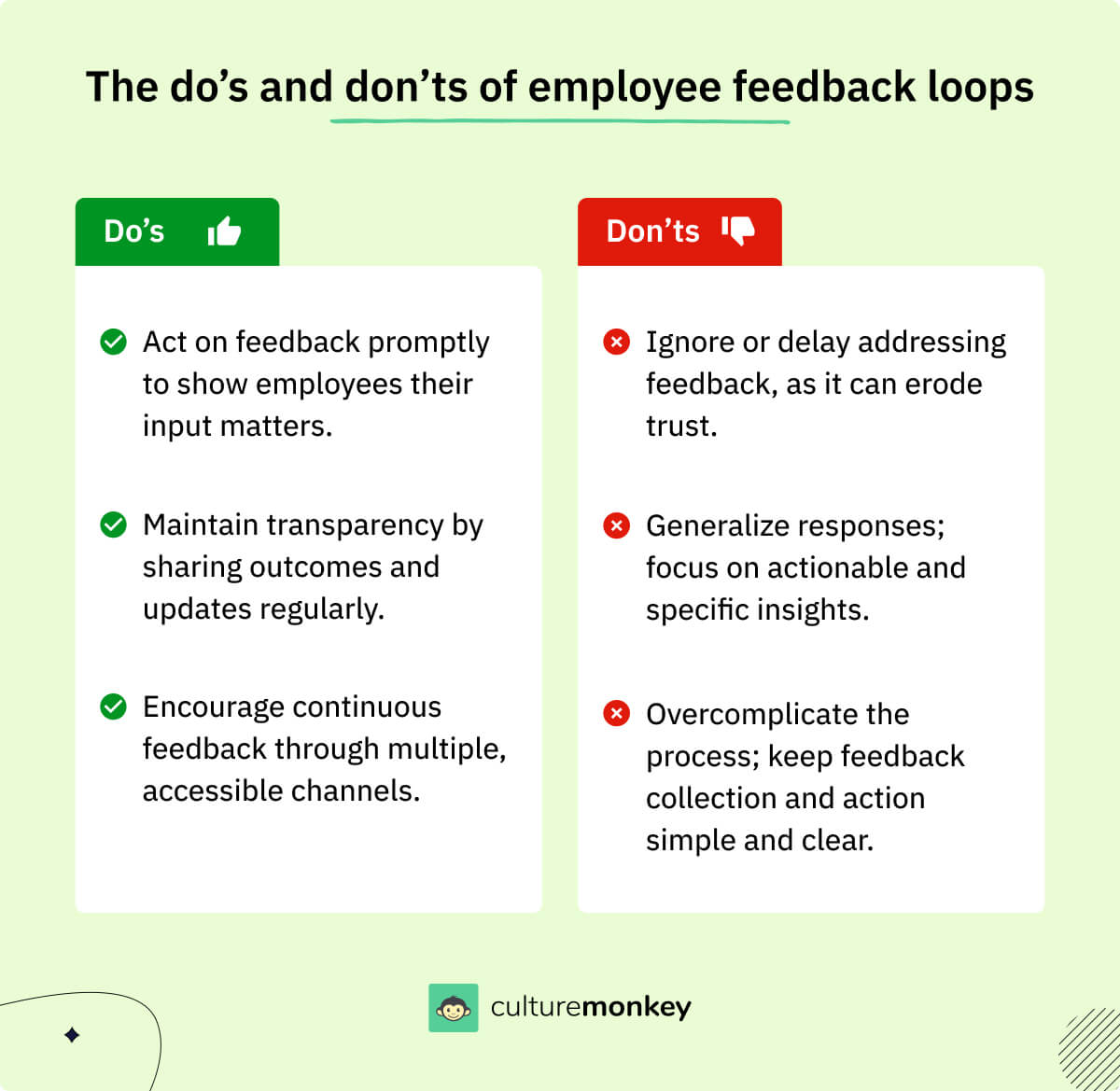
Importance of employee feedback surveys
Employee feedback surveys hold significant importance in organizations for several reasons:
- Employee engagement and satisfaction: Feedback surveys provide a platform for employees to share their thoughts, opinions, and concerns about their work environment, job satisfaction, and overall employee experience. Organizations demonstrate their commitment to employee engagement and satisfaction, leading to a more motivated loyal, and engaged workforce.
- Employee development and growth: Surveys provide an opportunity for employees to express their career aspirations, training needs, and desires for growth. Understanding these aspirations allows organizations to align employee development initiatives with individual goals, creating a more personalized and supportive approach to employee growth.
- Enhancing communication and transparency: Feedback surveys promote open communication, encouraging employees to share ideas and providing management with valuable insights. This two-way dialogue builds trust, boosts morale, and enhances performance, fostering a positive organizational culture.
- Innovation and ideas: Employee engagement survey provide a platform for employees to share ideas for process improvements and innovation. Front-line insights into operations and customer interactions are invaluable. Acting on these ideas fosters a culture of innovation and strengthens the company’s competitive edge.
- Diversity and inclusion: Employee feedback surveys reveal diversity and inclusion issues, helping organizations identify biases and barriers. Addressing these concerns fosters fairness, equality, and belonging, creating a more inclusive workplace. This strengthens the organization's reputation as a forward-thinking employer.
- Benchmarking and comparisons: Surveys help organizations benchmark performance and employee satisfaction against industry standards, highlighting strengths and weaknesses. This context enables realistic goal-setting for improvement. Benchmarking also ensures a competitive workplace to attract and retain top talent.
What is the purpose of continuous feedback?

Continuous feedback is like the heartbeat of growth and improvement in any domain, from the workplace to employee development. Its purposes are multi-faceted and powerful, all working in tandem to drive progress. Let's delve into the key purposes of continuous feedback:
- Enhancing learning: Continuous feedback is the lifeblood of learning. Employees receive feedback on their assignments and projects, helping them understand where they excel and where they need to focus more. This constructive criticism fuels the learning process and fosters growth.
- Goal achievement: Feedback keeps you on the path to achieving your goals. By regularly assessing your progress and receiving input from mentors or peers, you can adjust your strategies and stay on track. It's like having a GPS for your life goals, ensuring you reach your destination.
- Product and service refinement: In the business world, continuous feedback is invaluable for product development and service improvement. Feedback helps companies identify pain points, bugs, and feature requests, allowing them to refine their offerings and enhance customer satisfaction.
- Employee development: Organizations that embrace continuous feedback empower their employees to grow and excel. Regular performance discussions and coaching sessions enable employees to develop their skills, address weaknesses, and advance in their careers.
- Conflict resolution: Feedback isn't just about praise; it also helps resolve conflicts. When issues arise in personal or professional relationships, open ended and honest feedback can pinpoint the root causes and pave the way for resolution and reconciliation.
Continuous feedback loop strategies
By incorporating these strategies, you can establish a robust continuous feedback loop that fosters growth, promotes open communication, and empowers individuals and organizations to reach their full potential. It's all about creating a culture where feedback is not just a routine task but a dynamic force for positive change.
Let's explore a few effective strategies for implementing a continuous feedback loop, which is crucial for ongoing growth and improvement:
- Set clear objectives: Start by defining what you want to achieve with your feedback loop. Whether it's enhancing product quality, boosting employee performance, or improving customer service, clear objectives provide direction.
- Frequent check-ins: Regularly scheduled check-ins between manager and employee or team leader and team member provide opportunities for feedback. These team meetings should be a blend of discussing progress, challenges, and setting new goals.
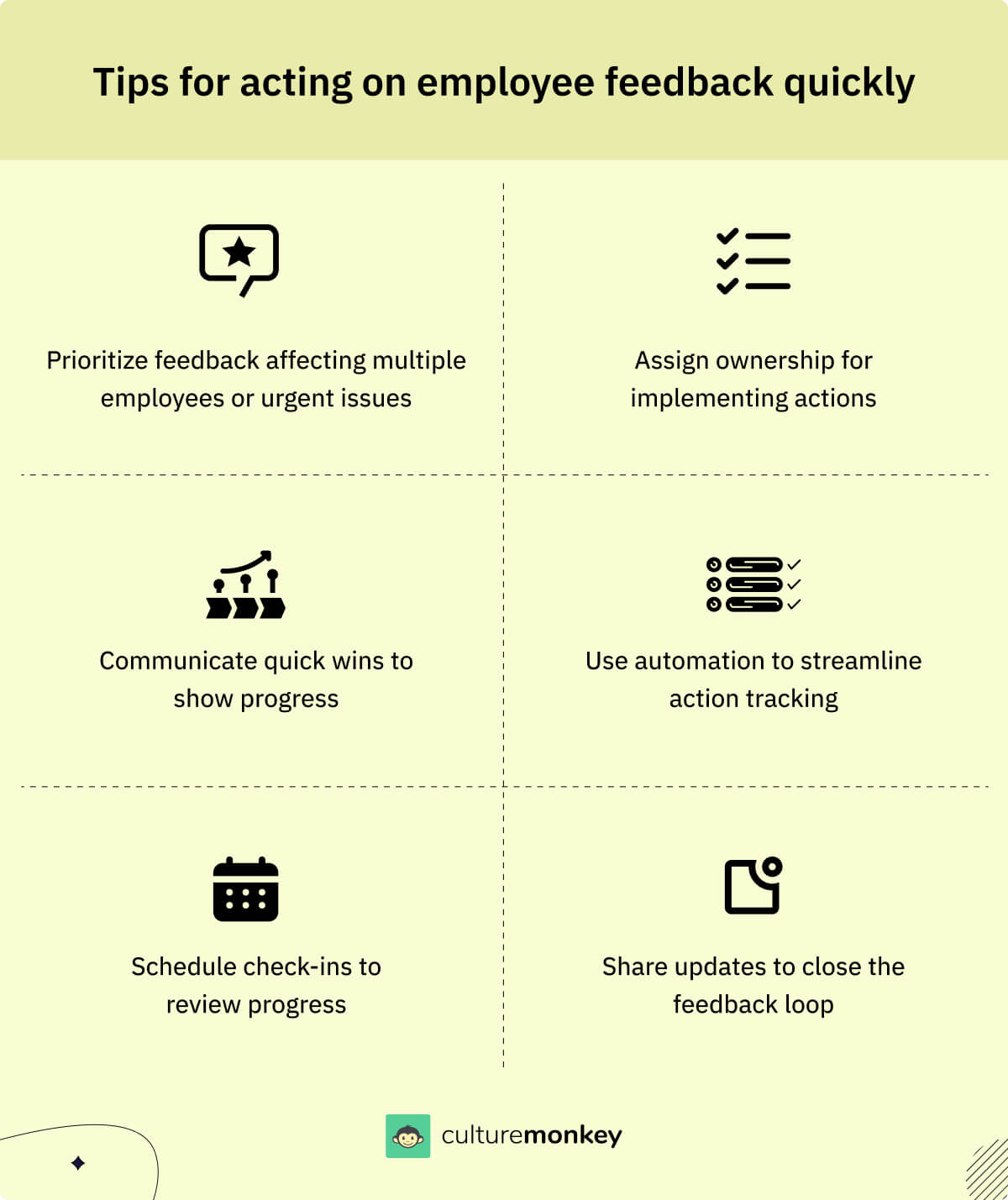
- Real-time feedback tools: Use technology to facilitate real-time feedback. Apps and software platforms enable quick and continuous communication, making it easier for feedback to flow naturally.
- Training and skill building: Provide training on giving and receiving feedback effectively. This ensures that everyone in the organization is equipped with the necessary skills for constructive communication.
- Recognition and rewards: Acknowledge and reward outstanding performance. Positive reinforcement encourages individuals to continue excelling and actively seek feedback.
- Transparent communication: Create a culture of transparency where feedback is expected and valued. When employees or team members know their voices are heard, they are more likely to participate in the feedback loop.
- Continuous improvement: Use feedback to drive action and make continuous improvements. Make it a habit to analyze feedback data, identify trends, and implement changes accordingly.
- Evaluation and monitoring: Regularly assess the effectiveness of your feedback loop strategies. Are you achieving your objectives? If not, adjust your approach and continue to refine the process.
Mistakes to avoid in implementing an employee feedback system

Here are some mistakes to avoid when implementing feedback loops:
- Lack of clear purpose and goals: Implementing a feedback system without a clear purpose or defined goals can lead to confusion and disengagement. It's crucial to establish a clear objective for gathering feedback and communicating it effectively to employees. This helps align their participation with the overall purpose, ensuring meaningful and focused feedback.
- No action or follow-up: Collecting feedback without action or follow-up frustrates employees. Show their input is valued by implementing tangible changes. Regularly communicate the progress made and the impact of employee feedback to maintain trust and increase employee engagement.
- Inadequate anonymity and confidentiality: Confidentiality is crucial for encouraging honest communication and open feedback. If employees fear reprisal or lack confidence in the anonymity of the feedback system, they may provide biased or incomplete responses. Implement measures to ensure anonymity, such as using third-party platforms or aggregating responses to maintain confidentiality.
- Ignoring negative feedback: A common mistake is dismissing or disregarding negative feedback or dissenting opinions. Take the time to understand the underlying concerns and address them constructively. Embrace diverse perspectives and use feedback as a catalyst for positive change.
- Failing to close the feedback loop: Neglecting to implement employee feedback loops that communicate the outcomes and actions taken based on feedback can lead to employee disengagement.
- Overloading with team survey: Bombarding employees with an excessive number of feedback surveys can lead to employee engagement survey fatigue. It's important to strike a balance and avoid overwhelming employees with too many requests for feedback.
- Not tailoring feedback methods: Different employees may have varying preferences for providing feedback. Some may prefer one-on-one discussions, while others may feel more comfortable using digital platforms or suggestion boxes.
- Inconsistent timing: Timing is crucial when implementing an employee feedback system. Gathering feedback too infrequently can make employees feel unheard and undervalued. Conversely, collecting feedback too frequently without acting on it can lead to frustration.
What is a positive feedback loop?
A positive feedback loop refers to a self-reinforcing cycle where a small initial change or stimulus leads to further amplification and growth in the same direction. In this loop, the output or response reinforces the original input, creating a more continuous feedback cycle of positive change. The result is an exponential increase in the magnitude or impact of the initial change.
While positive feedback loops can generate rapid growth or change, they can also have negative consequences if unchecked. In some cases, they may lead to instability, system failure, or undesired outcomes.
It's important to recognize and understand positive feedback loops to manage and regulate them effectively, ensuring they contribute to desired outcomes and sustainable growth.
Difference between positive and negative feedback loop

A positive feedback loop and a negative feedback loop are two contrasting mechanisms that describe how systems respond to changes or disturbances. Here are the key differences between them:
| Aspect | Positive feedback loop | Negative feedback loop |
|---|---|---|
| Mechanism | Amplifies changes and drives growth in the same direction. | Counteracts changes to maintain stability and equilibrium. |
| Self-reinforcement | Response reinforces the original input, creating a cycle of escalation. | Response opposes the original change, creating a self-correcting cycle. |
| Impact on stability | Can lead to instability, extreme outcomes, or system failure. | Promotes stability, preventing extreme deviations and maintaining balance. |
| Examples | - Positive peer recognition increases morale, encouraging more recognition across the team. - High sales targets achieved lead to setting even higher, motivating greater effort but potentially causing stress. | - Regular feedback correcting errors helps employees improve and maintain consistent performance. - Monitoring workloads prevents burnout by balancing responsibilities across the team. |
Top 5 employee feedback statistics
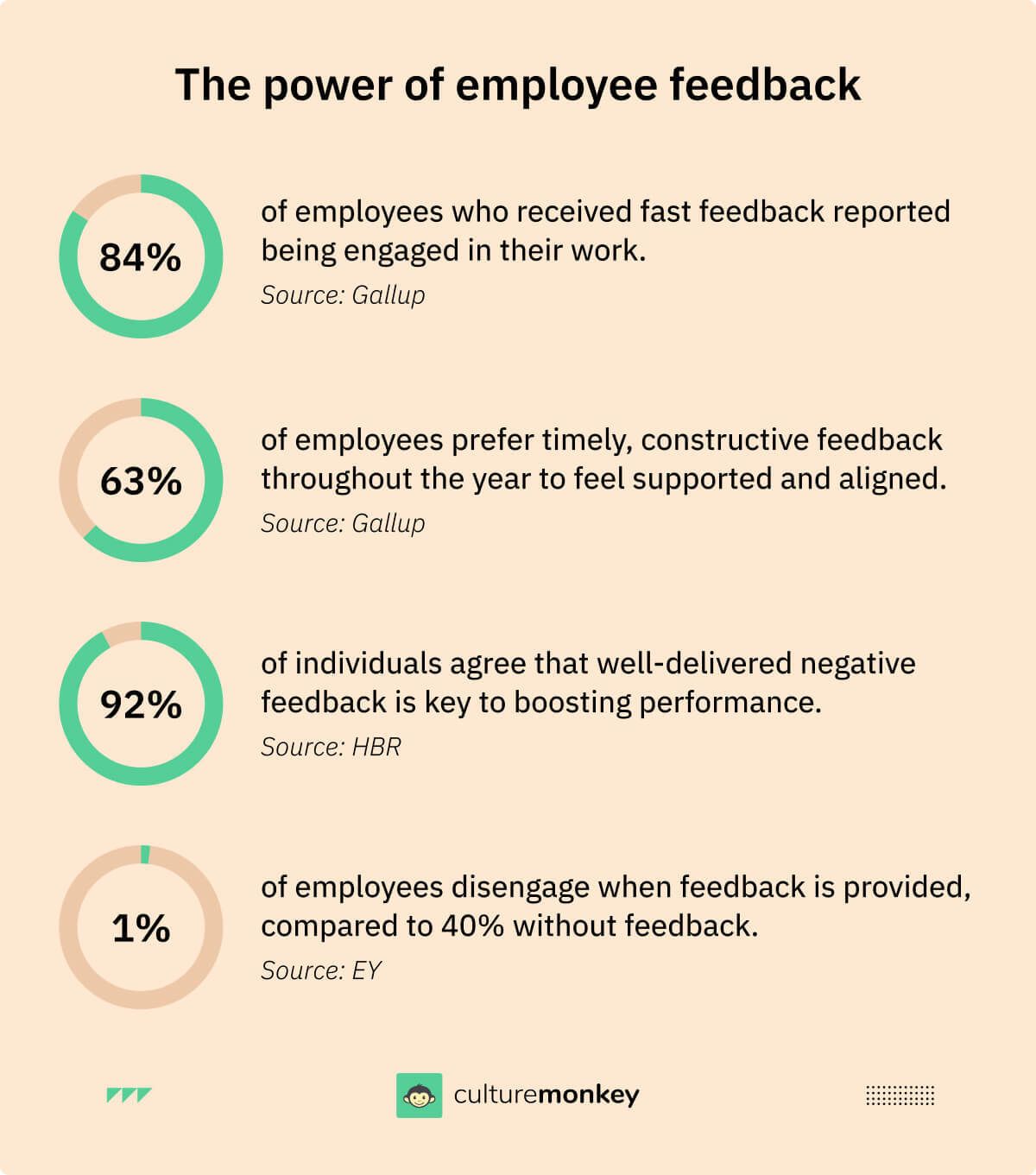
- Feedback boosts retention: According to Gallup, among 65,672 employees studied, those who received feedback on their strengths experienced a 14.9% decrease in turnover rates.
- Alarming employee engagement levels: Gallup reports that a significant 85% of employees are either disengaged or actively disengaged in their workplace.
- Discrepancy in feedback perception: Harvard Business Review (HBR) highlights a significant disconnect – while 49% of C-suite executives believe their companies excel at acting on employee feedback, only 31% of workers share this sentiment.
- HR leaders embrace peer feedback: Forbes reveals that 89% of HR leaders agree that continuous peer feedback and check-ins lead to successful outcomes.
- Daily feedback motivates employees: Gallup's research suggests that employees are 3.6 times more likely to strongly agree that they are motivated to excel at work when their manager provides daily feedback, compared to annual feedback.
Continuous feedback loop examples

These examples demonstrate how organizations and individuals use this dynamic process for ongoing improvement.
- Agile software development: In the world of software development, the Agile methodology thrives on continuous feedback. Developers release small increments of their software, gather feedback, and then iterate on their work. This iterative process ensures that the final product meets users' evolving needs and expectations.
- Customer support: Imagine you've reached out to a customer support team for assistance. They ask you for feedback after your interaction. Your input helps them identify areas where they can improve their service, whether it's reducing response times or enhancing the quality of support.
- Employee performance: Many organizations have shifted from annual performance reviews to ongoing feedback. Managers regularly meet with their team members to discuss progress, provide coaching, and set goals. This approach helps employees develop their skills and stay motivated.
- Product development: When creating new products, companies often use continuous feedback loops. They release beta versions to early adopters, collect user feedback, and use it to refine the product before the official launch. This iterative process results in products that better align with customer needs.
- Educational feedback: In education, continuous feedback is a valuable tool. Teachers give students regular assessments and feedback on their work, helping them understand where they excel and where they need improvement. This ongoing feedback aids in the learning process.
- Performance metrics: Businesses track various performance management system daily or weekly. For example, e-commerce websites monitor conversion rates, page views, and bounce rates. These metrics provide real-time feedback, allowing companies to make immediate adjustments to their strategies.

Feedback that delivers results.
Leave traditional feedback systems behind. The Feedback Cycle: Key Questions for Every Stage dives deep into the insights that fuel engagement and growth—because your team deserves meaningful change.
Feedback mechanisms in the workplace
Feedback is the engine that drives workplace improvement, like a finely tuned machine running at peak performance. But it's not just about giving a pat on the back or pointing out flaws; it's about using various feedback mechanisms to keep the wheels of progress turning.
- Traditional performance reviews: Let's start with the classics. Annual or semi-annual performance reviews offer a structured way to evaluate an employee's work. They provide an opportunity to set goals, discuss achievements, and identify areas for growth. However, they shouldn't be the only feedback mechanism in your arsenal.
- Continuous feedback: Waiting for an annual review to discuss performance is like waiting for the New Year to start your resolutions. Continuous feedback, given regularly and informally, keeps employees on track. It's about providing real-time insights, recognizing achievements, and addressing issues promptly.
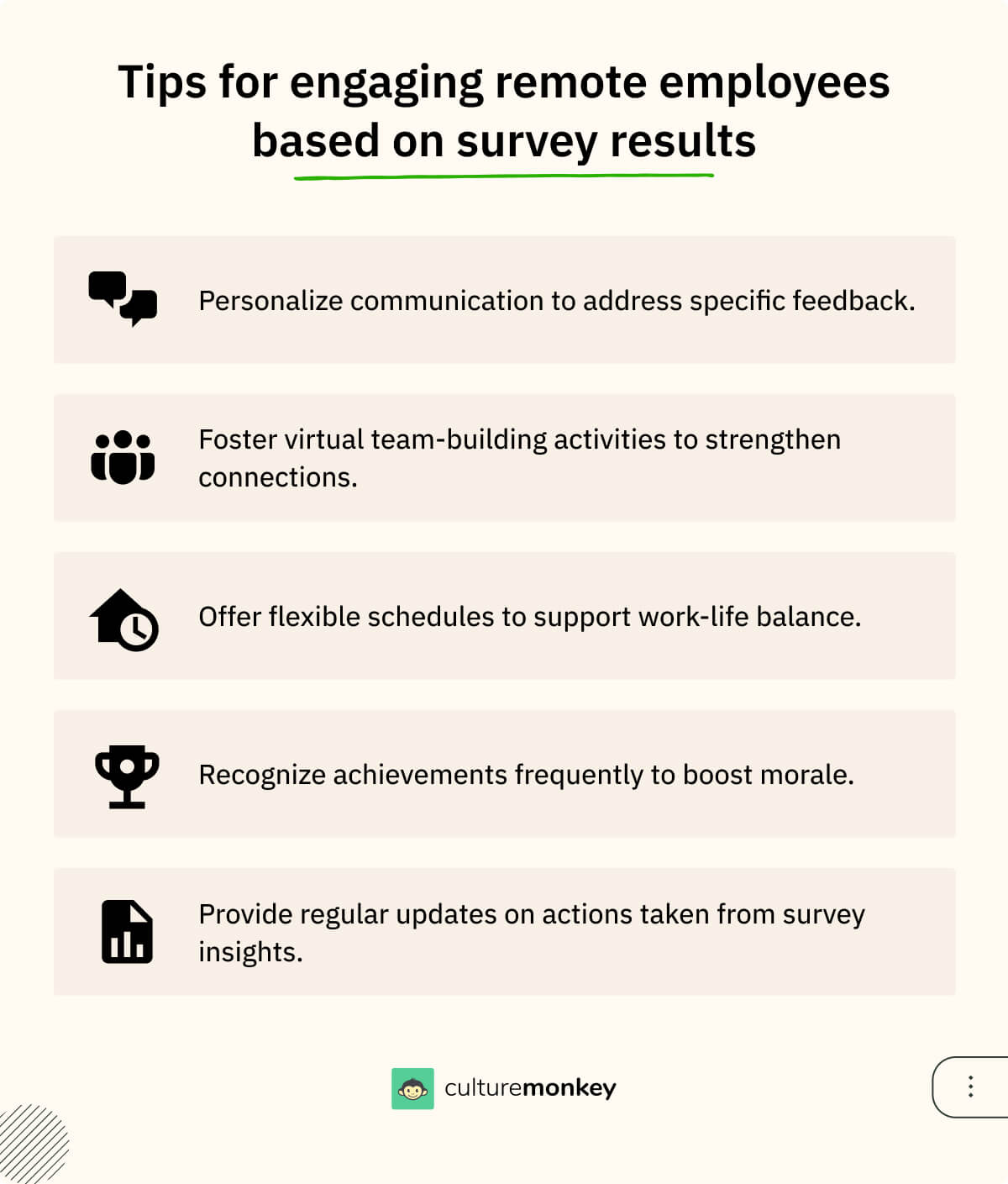
- 360-Degree feedback: Imagine getting feedback not only from your manager but from peers, subordinates, and even clients. That's what 360-degree feedback offers. It provides a holistic view of an employee's performance, fostering self-awareness and promoting a culture of accountability.
- Anonymous feedback surveys: Sometimes, employees might be hesitant to speak up openly. Anonymous feedback surveys provide a safe platform for employees to share their thoughts, concerns, and suggestions. These anonymous employee engagement surveys can uncover hidden issues and help you make data-driven decisions.
- Peer feedback: Your colleagues are your best critics and cheerleaders. Encouraging peer-to-peer feedback promotes collaboration and a sense of camaraderie. It's not just about managers providing input; it's about everyone in the team helping each other grow.
- Manager check-ins: Regular one-on-one meetings between managers and employees are goldmines for feedback. These discussions delve into individual progress, challenges, and career development. They're a chance for employees to ask questions and get guidance directly from their managers.
- Employee suggestion box: The age-old suggestion box might sound quaint, but it's a valuable feedback mechanism. It allows employees to share ideas and innovations without fear of judgment. And who knows, the next big company-changing idea could come from that humble box.
These feedback mechanisms aren't mutually exclusive; they can and should coexist in your workplace. Variety is the spice of life, and it's also the spice of feedback. Different situations call for different approaches, so having a mix of feedback mechanisms ensures that you address a variety of needs.
Effective employee feedback channels
Establishing robust communication channels for employee feedback is essential to fostering transparency and engagement. Beyond traditional methods, leveraging diverse communication channels ensures every voice is heard. Here are some effective channels:
- Internal chat platforms: Utilize tools like Slack or Microsoft Teams to create dedicated feedback channels. These platforms enable quick, casual feedback exchanges and encourage real-time communication among employees and managers.
- Mobile apps: Mobile feedback apps provide employees with a convenient and accessible way to share their input anytime, especially for remote or deskless workers.
- Feedback kiosks: Physical kiosks placed in common areas enable employees to submit feedback conveniently, especially in industries like retail or manufacturing where desk access is limited.
- Anonymous email portals: Setting up an anonymous email address for feedback allows employees to express concerns or suggestions without fear of identification.
- Virtual suggestion boards: Digital boards allow employees to post ideas or feedback and upvote others' suggestions, creating a transparent, collaborative feedback process.
- Quarterly feedback forums: Regularly scheduled forums provide structured opportunities for employees to share their insights with management in a group setting.
- Social media groups: Private groups on platforms like Workplace by Meta offer informal spaces for employees to discuss ideas and share feedback.
What is closed feedback loop?

A closed feedback loop, is like a well-contained circle of communication within a system. It's all about collecting and processing information from one end and then, well, closing the loop by applying that knowledge to improve or fine-tune the system.
Think of it as a way to continuously refine and optimize a process or product. Whether it's in the world of business, technology, or even your everyday life, a closed feedback loop helps ensure that you're not just gathering data for the sake of it, but actually using it to make things better.
Now, here's the kicker: a closed feedback loop is like a never-ending improvement cycle. You gather data, you analyze it, you make changes based on what you've learned, and then you do it all over again. It's a beautiful dance of information and action that keeps things evolving and getting better.
So, in a nutshell, a closed feedback loop is all about harnessing the power of feedback to create a continuous cycle of improvement. It's like having your own personal feedback-driven engine that keeps your processes, products, or systems running at their best. And who doesn't want that?
Closed-loop feedback best practices
Closed-loop feedback isn't just a fancy term; it's a powerful tool for improvement. But like any tool, it works best when you know how to use it effectively. So, let's dive into some closed-loop feedback best practices to ensure you're getting the most out of this valuable process.
- Define clear objectives: Before you even start, make sure you have a crystal-clear understanding of what you want to achieve with your feedback loop. Are you looking to improve customer satisfaction, boost product quality, or enhance employee performance? Knowing your objectives sets the stage for a successful feedback loop.
- Choose the right metrics: Feedback should be based on concrete data. Select relevant metrics or key performance indicators (KPIs) to measure progress accurately. These metrics will serve as the foundation for your feedback loop.
- Collect data continuously: Feedback isn't a one-and-done deal. Regularly collect data from various sources, such as team surveys, employee evaluations, or product usage analytics. This ongoing data collection ensures you have a continuous stream of information to work with.
- Analyze thoroughly: Once you have your data, dig deep into it. Identify trends, patterns, and areas where improvement is needed. The more thorough your analysis, the more targeted your actions can be.
- Act swiftly: The "closed loop" part comes into play here. As soon as you identify areas for improvement, take action. Whether it's adjusting a business process, refining a product feature, or addressing an employee's performance issue, swift action demonstrates your commitment to improvement.
- Communicate changes: Keep all stakeholders in the loop. If you've made changes based on feedback, let your customers, employees, or team members know. Transparency builds trust and shows that you value their input.
- Monitor and measure results: Implementing changes is just the beginning. Continuously monitor the impact of those changes using the same metrics you used to collect feedback initially. Are you seeing improvements? If not, it might be time to adjust your approach.
- Iterate and improve: Closed-loop feedback is a continuous cycle. Use the results of your monitoring to iterate and make further improvements. Keep the loop going to ensure ongoing progress.
- Encourage participation: Actively seek out feedback from all relevant sources. Encourage open communication and create a culture where feedback is welcomed and valued.
- Invest in technology: Consider using feedback management software or tools to streamline the process. These tools can help you collect, analyze, and act on feedback more efficiently.

Make feedback work for your team
Explore 7 dynamic activities that defy traditional feedback methods. These exercises encourage creativity, build trust, and transform how your team communicates and grows together.
Importance of an employee feedback tool for a strong feedback loop

An employee feedback tool plays a vital role in establishing and sustaining an effective feedback loop. Here are the key reasons why an employee feedback tool is important for implementing a rock-solid employee feedback loop system:
- Streamlined data collection: An employee feedback tool provides a centralized platform for collecting feedback, making the process efficient and organized. It allows for the easy creation and distribution of surveys, questionnaires, or feedback forms, ensuring that feedback is collected consistently and comprehensively.
- Real-time feedback: An employee feedback tool enables real-time feedback, allowing for timely responses to emerging issues and concerns. Employees can provide feedback whenever necessary, ensuring that their voices are heard promptly and addressing any potential challenges before they escalate.
- Data analysis and insights: Feedback tools often include analytical features that facilitate data analysis. They generate reports, metrics, and visualizations to help organizations gain valuable insights from the feedback data. These insights enable informed decision-making and the identification of trends, strengths, weaknesses, and areas for improvement.
- Accountability and follow-up: An employee feedback tool helps in tracking and documenting feedback, ensuring accountability and follow-up on action items. It allows organizations to assign responsibilities, set deadlines, and monitor progress in addressing feedback. This promotes a sense of ownership and ensures that feedback leads to tangible outcomes.
- Data security and privacy: Employee feedback tools often prioritize data security and privacy. They employ robust security measures to protect sensitive employee information, ensuring compliance with data protection regulations. This instills confidence in employees that their feedback is treated with care and confidentiality.
- Scalability and flexibility: An employee feedback tool is scalable and adaptable to organizational growth and changes. It can accommodate feedback from a small team to an entire organization, allowing for customization based on specific feedback needs. The flexibility of the tool ensures it can evolve with the organization and accommodate future requirements.
- Integration with existing systems: An employee feedback tool can seamlessly integrate with other HR and organizational systems, such as performance management, learning and development, and employee engagement platforms. This integration allows for a holistic view of employee performance and development, creating a more cohesive and efficient workflow.
- Customizable feedback templates: Many employee feedback tools offer customizable templates that cater to various feedback scenarios. Organizations can tailor these templates to specific departments, roles, or feedback goals, ensuring that the feedback collected is relevant and actionable.
How can Culturemonkey’s employee feedback survey tool help?
Implementing an employee feedback tool through a platform like CultureMonkey offers significant benefits for organizations striving to improve engagement, foster transparency, and drive meaningful change.
- Unlock actionable employee insights: Analyze employee feedback with heat maps showing engagement scores across teams, locations, and demographics. Identify key areas like leadership and communication for improvement. Transform insights into targeted action plans to enhance the employee experience.
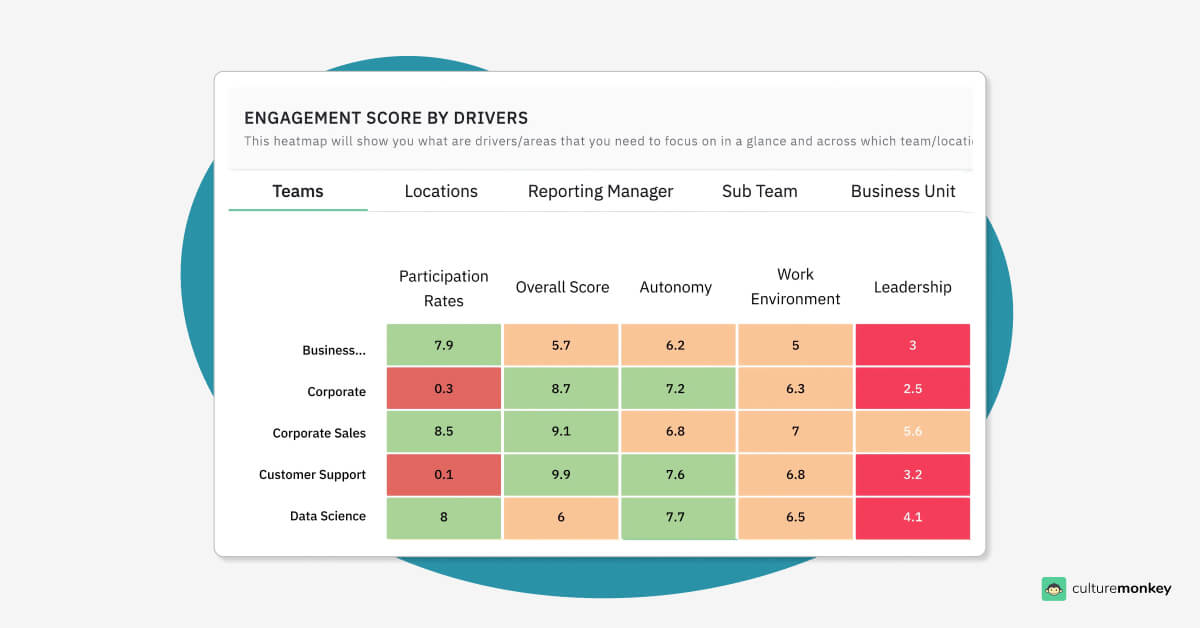
- Understand employee sentiment: Use feedback analytics to assess employee sentiment and job satisfaction across your organization. CultureMonkey’s sentiment analysis automatically categorizes feedback into positive, negative, and neutral. Access GPT-powered reports to uncover key insights and improve workplace culture.
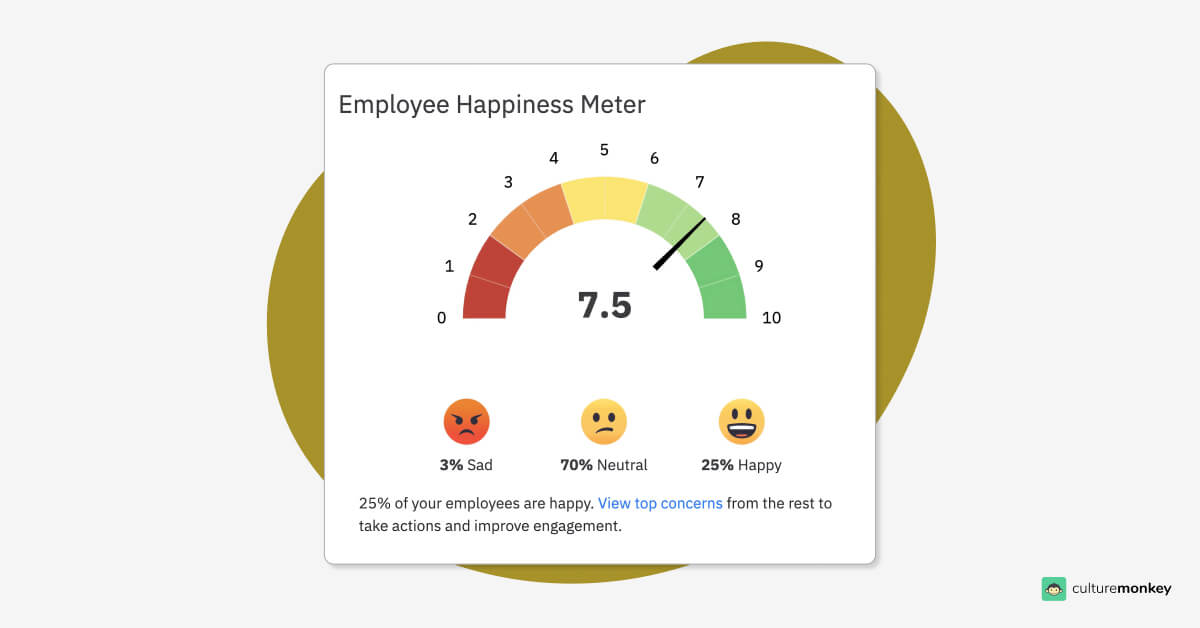
- Simplify employee feedback analysis: Easily filter and customize employee survey reports with CultureMonkey’s dynamic tools, saving time and effort. Measure key metrics in an intuitive format to make data-driven decisions. Access insights like participation rates for a complete understanding of employee sentiment.
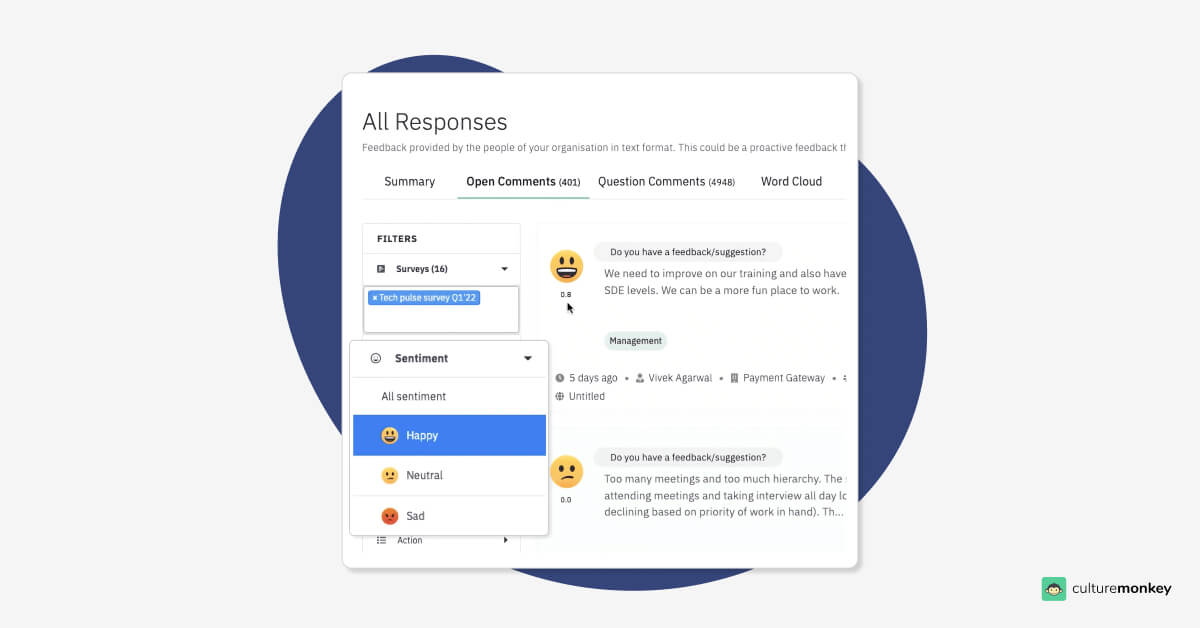
- Drive engagement with data-driven actions: Use employee feedback tools to identify attrition trends and take proactive steps to reduce turnover. Leverage AI recommendations to address employee issues and improve retention. Track progress through manager dashboards to boost engagement and manager effectiveness.
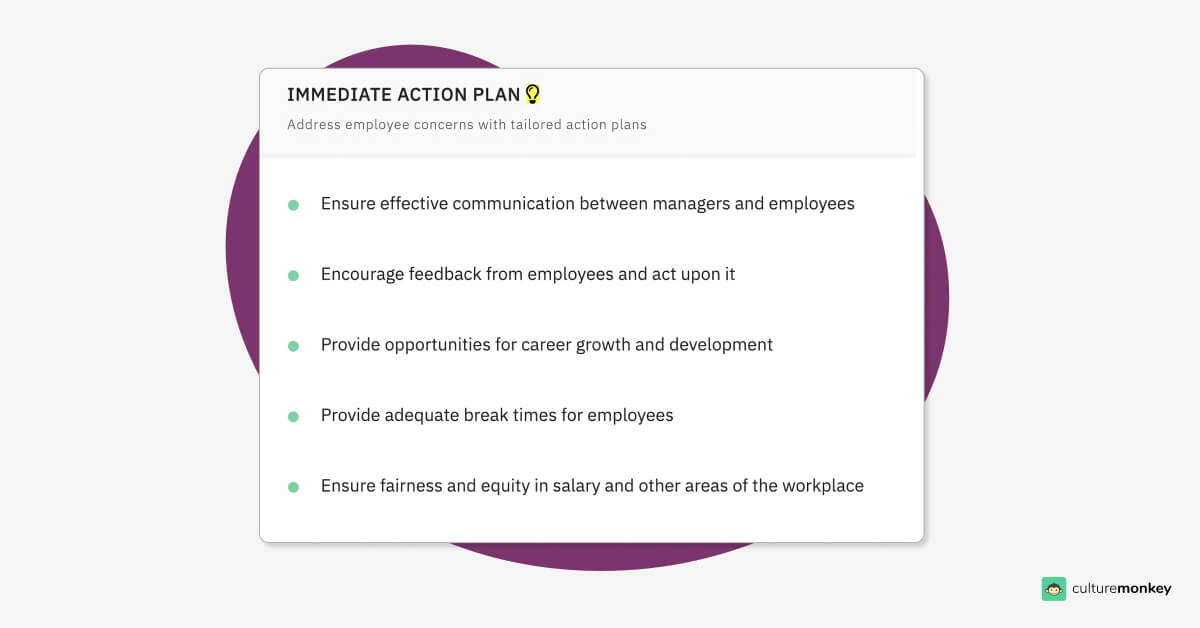
Conclusion
Think of the employee feedback loop as the Apollo 11 mission—collaborative, precise, and constantly iterating. NASA didn’t just launch a rocket and hope for the best; they relied on a constant feedback loop between engineers, astronauts, and mission control to adapt and succeed. Your workplace should work the same way.
A strong employee feedback loop keeps your organization aligned, innovative, and thriving. It’s about more than collecting thoughts—it's about taking action that builds trust and improves performance. Tools like employee feedback survey platforms simplify the process, making feedback collection and analysis seamless.
If you're looking to implement a solution that integrates feedback into your company culture effectively, consider using CultureMonkey. It’s designed to help organizations like yours amplify employee voices and build stronger teams. Ready to elevate your feedback game? Start now.
Summary
Employee feedback loops are essential for fostering communication, trust, and continuous improvement in the workplace. By regularly collecting and analyzing employee feedback on key areas such as performance, collaboration, and workplace culture, organizations gain actionable insights to drive meaningful change.
Implementing feedback-based actions helps address challenges, reinforce strengths, and enhance employee satisfaction. A well-maintained feedback loop creates a transparent, inclusive environment that boosts engagement, reduces turnover, and supports long-term organizational success.
FAQs
1. Why is employee feedback important for retention?
Employee feedback is vital for retention because it gives employees a voice, demonstrates their value, and fosters a sense of ownership. When employees feel heard, recognized, and actively involved in decision-making processes, they become more engaged, satisfied, and deeply committed to the organization, leading to higher retention rates, loyalty, improved morale, stronger workplace relationships, and sustained organizational growth over time.
2. How does the employee feedback loop impact engagement?
The employee feedback loop positively impacts engagement by creating a culture of open communication and continuous improvement. Regular feedback encourages dialogue, identifies areas for growth, and provides opportunities to address concerns effectively. Engaged employees who receive and contribute to feedback feel valued, motivated, and connected to the organization’s goals, making them more likely to stay with the company and perform at their best.
4. How can employee feedback be used to improve retention rates?
Employee feedback can be used to improve retention rates by identifying pain points, recognizing strengths, and implementing changes based on employee insights. When employees see their feedback leading to tangible actions and improvements, they feel valued, heard, and appreciated. This boosts their morale, strengthens their trust in leadership, enhances workplace satisfaction, and increases their likelihood of remaining committed and loyal to the organization over the long term.
5. What is a negative feedback loop?
A negative feedback loop is a regulatory mechanism where the output of a system dampens or reduces the initial stimulus, thereby maintaining stability or equilibrium. This process counteracts deviations from a set point, ensuring consistent performance, reliability, and balance. In organizational contexts, it helps correct behaviors and processes by providing corrective feedback, fostering continuous improvement, adaptability, and long-term operational efficiency.




